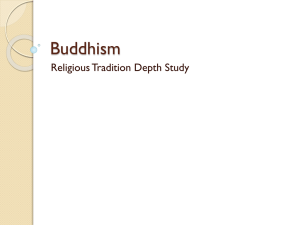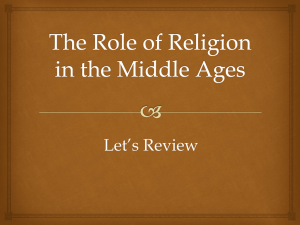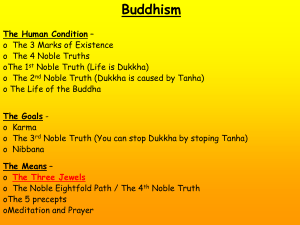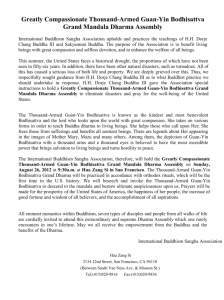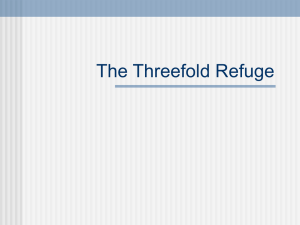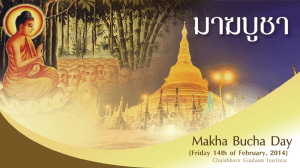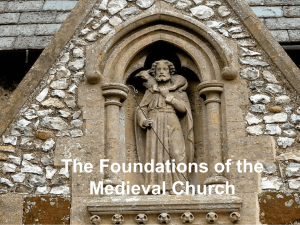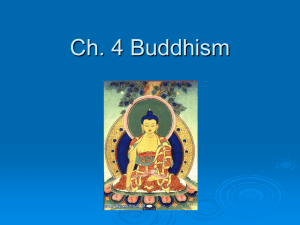The Sangha
advertisement
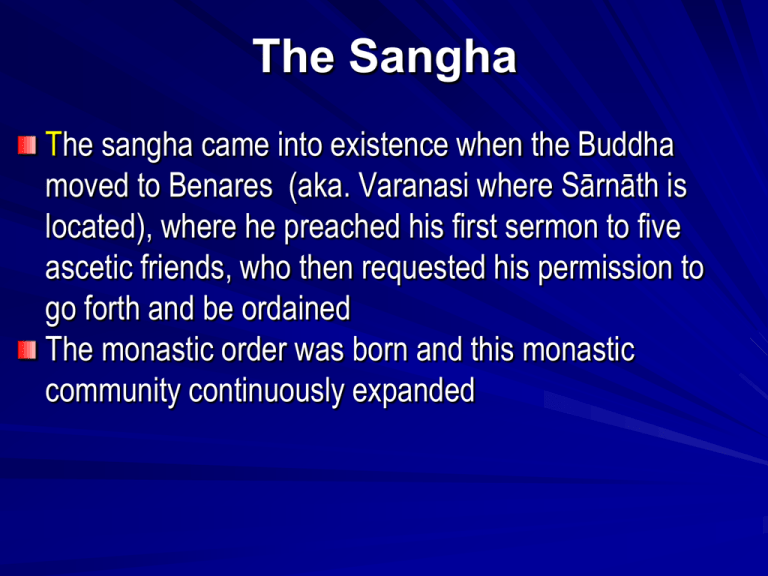
The Sangha The sangha came into existence when the Buddha moved to Benares (aka. Varanasi where Sārnāth is located), where he preached his first sermon to five ascetic friends, who then requested his permission to go forth and be ordained The monastic order was born and this monastic community continuously expanded Chinese translation of Sangha is seng 僧 or sengqie 僧伽, which represented Sangha in the time of the Buddha – Bhikşu-sangha (community of monks) – Bhikşuņī-sangha (community of nuns) – They are known as the “twofold community” Therefore, “Sangha” is defined as the community of ordained monks and nuns • where the Buddha’s teachings were taught and spread • where Buddhist scriptures were compiled • where the clergy and laypersons congregated • where monks and nuns practiced meditation • To be ordained into monkhood, one had to undergo a “Threefold Recitation” of this formula: •I go to the Buddha for refuge, •I go to the Dharma for refuge •I go to the Sangha for refuge • In time, Sangha developed into monasteries that served as festival and pilgrimage sites Sangha and Laity • • Laypersons accepted by Sangha as upāsakas (male disciples) and upāsikās (female disciples) Sangha and laity formed a symbiotic monastic-lay relationship • laity provided material support for monks and nuns to establish “field of merit” monks and nuns provided a locus for laypersons’ worship, wise counsel, and Dharma instruction •What were the sources of “dharma instruction”,or “teachings” ? • Buddhist scriptures • The Buddha’s words • disciples’ oral transmission-->oral literature • oral literature-->1st representation of the dharma Five Precepts (Five “not to” vows) Five precepts (vows) governed laypersons’ ethical conduct • Not to kill (or to abstain from taking life,killing) • Not to steal (or to abstain from that which is not given/stealing) • Not to commit sexual misconduct (to abstain from sexual misconduct) • Not to lie and deceive (to abstain from false speech) • Not to use intoxicants (abstain from intoxicating substances) Buddhism after the Death the Buddha No Successor, authority, or absence of central authority led to-• Formation of variant traditions, which differed in • interpretations of the teachings in general • interpretations of specific ideas • interpretations of monastic rules Elder monks led monastic life • Textual • concerned with the study of the theory as preserved in Buddhist writing • Practice • concerned with putting the system of training into practice The Schism Tensions rose • among “textual studies” people, • “textual studies” and “practice” groups Elders and Universal (or Great) Assembly • both fragmented into sub-schools • most of these groups died out • Theravada among Nikaya survived What disputes? • Doctrinal dispute: to be Arhat or Buddha? • New monastic rules needed? Questions regarding teaching: • • • • authority authenticity reliability credibility Questions regarding learning • method of teaching • method of memorizing Questions regarding curriculum: • nirvana or vinaya? • Five “not to” vows Mahāyāna Buddhism Greater Vehicle, Bodhisattva-yāna (the vehicle of Bodhisattvas – The concept of saviors and compassion – Multiple Buddhas and Bodhisattvas – elevation of the Buddha and creation of new Buddhology The “three bodies” theory – Dhamakāya: symbol of ultimate truth, transcendent – Sambhogakāya: heavenly body, rewarded body, Buddha land – Nirmanakāya: earthly body, physical body, historical Buddha Practice of Mahāyāna Buddhism – follow Bodhisattva path, beginning with “bodhicitta” (thought/mind of enlightenment; awakening mind; Bodhi mind 菩提心) – One who has spontaneous wish and compassion to realize or motivate bodhicitta can become Bodhisattva. – Six pāramitās (Six Perfections) generosity (giving), morality, patience, courage (vigor) meditation, Wisdom The Bodhisattva Ideal : – Bodhicitta, Six perfections Ten Bodhisattva stages (bhūmi) leading to nirvana – The path of accumulation aspiration – The path of preparation meditation – The path of vision Eradication of old karma – The path of development New wisdom – The path beyond learning purification Three most important bodhisattvas – Maitreya, “Benevolent One,”—epitomizes power & Skillful means – Avalokiteśvara, “The Lord who looks down (in compassion)”-->epitomizes compassion – Maňjuśrī, “Gentle Glory”--epitomizes wisdom Mahāyana vs. Hīnayāna Mahāyāna Hīnayāna – Universal salvation – Individual salvation – Bodhisattva ideal – Arhat – Universal Buddhahood – Buddhahood found in chosen few Multiple Buddha lands and multiple Buddhas – Existence of celestial Buddhas and Bodhisattvas – Bodhicitta and Bodhisattva ideal Seven Buddhas – Eightfold path focusing on “Three Learnings”: wisdom, morality, and meditation The Clergy’s Life Uphold Vinaya: – The foremost of them: five precepts Lay people have to take vow to uphold them – Additional five precepts for monks and nuns: Not to eat after the noon meal Not to handle gold and silver Not to adorn their bodies Not to sleep in high beds Not to attend musical performances – Ordained monks (Bhikşu) and nuns (Bhikşuņīsangha ) took many more vows Seniority was given to monks. Senior nuns have to pay respect to junior monks Mahāyāna Sutras Major Mahāyāna Sutras • The Lotus Sutra (Sutra of the Lotus Blossom of the Fine Dharma) • One vehicle • Skillful means • the parable of the Burning House • The Vimalakīrti Sutra (Teachings of Vimalakīrti) • Layman Vimalakīrti – outwitted all Bodhisattvas – revealed the true meaning of the Mahāyāna • The Three Pure Land Sutras • Buddha Amitābha and His Pure Land • [Re]birth into the Pure Land Central Philosophy Middle Way (Madhyamaka) • Nāgārjuna (c. 150 - c. 250 CE) 龍樹 • the doctrine of emptiness (Śūnyatā) • associated with the concepts of impermanence and no-self • meditation helps see true reality • dependent-origination (dependent arising) • the principle of causality ( the twelve-linked chain of causation) Dependent Origination: Twelve-Linked Chain of Causation The Three Poisons: •Desire (pig) •Hatred (snake) •Ignorance (rooster) Dependent Origination: The Twelve-linked Chain of Causation 1. Blind man 2. stumbles 3. falls 4. a swelling develops 5. an abscess forms and weeps 6. abscess gets knocked and bruised 7. terrible pains 8. long to remove the pains 9. seizes on something that cures 10. applies medicine to cure 11. condition getting worse 12. the swelling bursts 1. Ignorance 2.disposition 3.consciousness 4.mind and body 5.six senses 6.contact 7.feeling 8.craving 9.grasping 10.becoming 11. birth 12. old age and death
